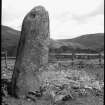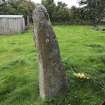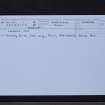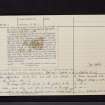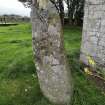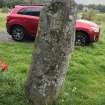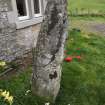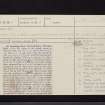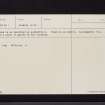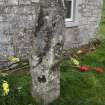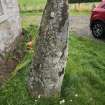Warrior's Rest
Cairn (Period Unassigned), Long Cist(S) (Early Medieval), Standing Stone (Prehistoric), Food Vessel(S) (Period Unassigned), Socketed Axehead (Bronze)(Period Unassigned)
Site Name Warrior's Rest
Classification Cairn (Period Unassigned), Long Cist(S) (Early Medieval), Standing Stone (Prehistoric), Food Vessel(S) (Period Unassigned), Socketed Axehead (Bronze)(Period Unassigned)
Canmore ID 53054
Site Number NT32NE 1
NGR NT 35446 27755
Datum OSGB36 - NGR
Permalink http://canmore.org.uk/site/53054
- Council Scottish Borders, The
- Parish Yarrow
- Former Region Borders
- Former District Ettrick And Lauderdale
- Former County Selkirkshire
NT32NE 1 3545 2775
See also NT32NE 11.
(NT 3545 2775) Standing Stone (NAT)
OS 6" map (1900)
Among discoveries at Annan Street there are recorded:
1. a standing stone bearing a latin inscription
2. a socketed bronze axe
3. a 'small ring of cannel coal'
4. 'portions of a clay urn' and
5. a flint arrowhead.
(3) and (4) were found in eight long cists. This area of ground was apparently taken into cultivation about 1807-8 and the remains are identified as those of a 'scene of slaughter and sepulchre'
J Hardy 1884.
(Similar information to the above, but with more details about the finds, also) 'A bronze celt was found in the garden at the same time, 4 in long and 2 1/2 in broad at the edge, with a socket to admit a handle, and a lateral loop'.
J Hardy 1885
Standing Stone and Cemetery, Warriors Rest. At the SE corner of the cottage known as Warriors Rest, 300 yds W of Yarrow Church (RCAHMS 1957, No. 10, NT32NE 9), there is a standing stone measuring 5ft 3 ins in height, 5ft 9 in round the base and 4 ft round the shoulder. The top is pointed.
In 1857 a group of eight stone-lined graves was found from 10 to 12 yds S of this stone.(J A Smith 1859) They were built of large slabs, measured from 5ft to 6ft in length, and were oriented E and W. Apart from traces of bone, the only contents of the graves were fragments of a Food Vessel and an Early Bronze Age ring of cannel coal with thin, perforated walls, (J G Callander 1916; V G Childe 1935) this ring and one small fragment of the Food Vessel are now in the National Museum of Antiquities.
Close by, a cairn of small round stones enclosed a quantity of partially decomposed bones, while numerous fragments of bones were cast up by the workmen employed in digging the foundations of the cottage. A flint arrow-head and part of a stone hammer (J A Smith 1868) were also found in the same area.
Subsequently a further stone-lined grave, also oriented E and W, was uncovered some 25 yds S of the main group. It measured 5ft 9ins in length by 12 to 16 in. in breadth and contained nothing but the skeleton of an adult male. (J A Smith 1868)
In spite of the fact that the food Vessel fragments and the ring were found in the graves, it seems most unlikely that they represent contemporary furnishings. Groups of stone-lined graves, oriented E
and W and lacking grave-goods, are characteristic of Christian and not pagan burials, (J Anderson 1868) and evidence of Christian burials in this area is provided by the inscribed stone (NT32NW 5). It is probable, therefore, that the site has been successively occupied by Bronze Age and Early Christian cemeteries, and that the appearance of the Food Vessel fragments and the ring in the later graves is due to the disturbance of the earlier interments.
RCAHMS 1957, visited 1949
"... the stone at the Warrior's Rest..., which marks the site of an Early Christian cemetery." (RCAHMS 1957, No.174)
The stone is as described by RCAHMS. There is no evidence of a cairn or graves in the vicinity. See also NT32NE 11.
Visited by OS (EGC) 5 June 1962.
Coles mistakenly locates Yarrow in the former county of Roxburghshire; his socketed axes Roxburghshire 31 and Selkirkshire 1 are in all probability the same. On the evidence of the coincident descriptions, Annan Street (NT32NE 11) and Warrior's Rest (NT32NE 1) are the same group of finds and monuments, within which the standing stones NT32NE 1 and NT32NE 2 the Yarrow Stone (NT32NW 5) are also situated.
Information from RCAHMS (RJCM), 18 April 1990.
NT32NE 1 NT 3545 2775
A site visit to this standing stone (N T32NE 1) was carried out in November 2003. Two previously unreported cup markings were marked on the E side of the stone, each c 20mm in diameter.
M Wilson 2005
Magnetometry (22 September 2014 - 7 November 2014)
A geophysical survey was conducted in the field around the Yarrow Stone and the adjacent field to the east in September 2014 by Archaeological Services Durham University. The works comprised geomagnetic survey of approximately 7ha. No features of probable archaeological significance were identified, however, it is possible that some of the anomalies could reflect the remains of ditches or pits. No features have been identified close to the Yarrow Stone, other than drainage ditches for the existing track. The stone may not have been re-erected exactly where it was originally discovered. A probable igneous dyke, and more subtle geological variation, has also been detected.
Information from OASIS ID: archaeol3-194457 (D Hale) 2014
Magnetometry (August 2015)
A geophysical survey was conducted around the Glebe Stone and to the west of Warrior’s Rest, Yarrow, near Selkirk, in the Scottish Borders in August, 2015. The works comprised geomagnetic survey of approximately 8.5ha. The works were commissioned by Dr David Petts of Durham University on behalf of Mr Jack McCrory and conducted by Archaeological Services Durham University. Although few features of probable archaeological significance have been detected there are a number of possible ditches and pits. For example, part of a possible rectilinear enclosure ditch has been identified south-east of the Glebe Stone, though the surveys have detected no evidence for any features closer to the stone. Occasional small circular anomalies have been detected across the site (for example in Areas 3 and 9), which could possibly reflect the remains of ring-ditches; these could possibly be associated with former cairns. It is likely that any cairns have been destroyed by the removal of stone, almost certainly to the field walls, and that little or no geophysical trace of them survives in the subsoil. Former ploughing of these fields will also have impacted upon any nearsurface features. Features relating to modern and recent agricultural practices have been identified, including former ploughing, land drains, former dykes and animal feeders. Probable geological and geomorphological variation has been detected across the survey area.
Sbc Note (15 April 2016)
Visibility: Standing structure or monument.
Information from Scottish Borders Council
Note (2 September 2020)
Date Fieldwork Started: 02/09/2020
Location Notes: The standing stone is as described in previous Canmore records. Investigation and 3D modelling by the Edinburgh, Lothians and Fife Team for Scotland's Rock Art Project. No cupmarks were visible on the stone. It had previously been reported that there were two possible cupmarks reported on the E side of the stone are natural, however, no such features whether natural or human made were seen. It is possible that the previous record related to the Glebe Stone (Canmore 53061) which is nearby.




















